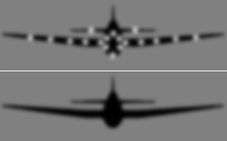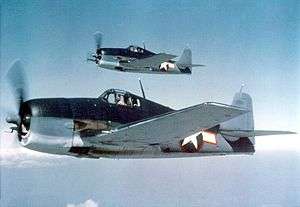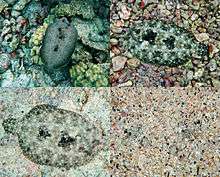Aircraft camouflage

Aircraft camouflage is the use of camouflage, typically in the form of light and color patterns, applied to military aircraft to make them more difficult to see on the ground, in the air, or to make their speed, distance or attitude harder to determine. Military camouflage is highly dependent upon environmental conditions and is primarily effective against human observers, though some electronic visual acquisition systems can also be confused. It does not hinder radar location or heat-seeking electronics although the paints used may contain substances that can.
Camouflage colours and patterns are subject to considerable experimentation and theorizing, and most countries have explicit specifications as to their application that are sufficiently unique to make it possible to determine the intended operator in many cases even when no national insignia is visible. The colours and patterns have changed over time, both as new theories were tried, and as operational requirements changed. During and after World War II, the Yehudi lights project explored counter-illumination camouflage using lamps to increase the brightness of the aircraft to match the background. Recent experiments have looked at the use of light-emitting active camouflage systems which allow the colours and patterns to be changed to match the background.[1]
Aircraft were first camouflaged during World War I, and camouflage has been widely employed in most major conflicts since then.
Camouflage has been dispensed with when air superiority was not threatened or when no significant aerial opposition was anticipated, to reduce the cost of maintaining matte camouflage finishes which add weight and drag to an aircraft, as well as requiring more frequent repainting.
Usage
Camouflage for aircraft is complicated by the fact that the appearance of the aircraft's background varies widely, depending on the location of the observer, the nature of the background[2] and the aircraft's motion. For this reason, many military aircraft were painted to match the sky when viewed from below, and to either match the ground or break up the aircraft's outline when viewed from above. This is known as countershading, and can be useful on aircraft such as heavy bombers that do not do much inverted flying during combat.[3] Because of the way light hits it, patterns of dark and light will often be present on an aircraft even if it is entirely one color, which will affect the apparent size of the aircraft.[4] Further emphasis in this direction can be made by painting an aircraft in several neutral shades with a non reflective, matte finish.[4]
Night camouflage
.jpg)
Military aircraft flying at night have often been painted black or other dark colours, applied to just the underside of some aircraft and to the entirety of others, to reduce the risk of being seen in enemy searchlights or by night fighters.[5] For example, night-flying Heinkel 111s were painted all black below, with dark flecked markings including some light gray or brown above.[6]
Ground camouflage

Camouflage is often used to delay visual acquisition from the air of an aircraft that is on or near the ground. A variety of patterns have been used to obscure aircraft outlines over specific environments. Light sand colors have been used for aircraft used over deserts, blues and greys for aircraft over the sea, and greens and browns for aircraft that are expected to operate in forested areas.[7] A camouflaged aircraft either on the ground or flying low over the ground in bright sunlight is vulnerable to being detected from above because of its own bold, black shadow cast on the ground.[8] This can reduce an aircraft's camouflage effectiveness at altitudes up to 3,000 feet (910 m), particularly if the ground surface is light colored and homogenous.[8]
Air camouflage
Camouflage for an aircraft that is in the air can have several purposes. Primarily, it attempts to hide the aircraft but failing that, it can disguise an aircraft's attitude or distance. Some camouflage effects used on fighters are to paint a mock cockpit on the underside of the aircraft, and to use countershading (painting areas that would normally end up shaded a lighter tone, and vice versa). An automimicry tactic such as this can confuse an enemy pilot as to the direction the falsely painted fighter will maneuver for long enough to gain a decisive advantage.[3]
The higher speeds of modern aircraft, and the reliance on radar and missiles to defend against them have reduced the value of visual camouflage, while increasing the value of electronic "stealth" measures.
Active camouflage

In the early years of World War II, German U-boats often escaped attack by aircraft because they spotted the aircraft while it was still far away as a black dot in the sky, no matter what camouflage colours were used. To solve this problem, in 1943 the U.S. Navy, following the Canadian diffused lighting camouflage trials, conducted secret experiments on counter-illumination under a project named "Yehudi". Sealed beam lights were mounted on the leading edge of the wing of a Grumman TBM-3D Avenger, and around its engine cowling, with the lamps facing forward. The intensity of the lamps was adjusted to match the background sky as seen from an observer in a surface ship. Aircraft with Yehudi lights were not spotted until 2 miles (3.2 km) away under conditions where aircraft without the lights were spotted 12 miles (19 km) away.[9] Though successful, the system was not put into production because of improved radar detection.[9]
During the Vietnam War, Yehudi lights were again tried, this time mounted to an F-4 Phantom painted in a dull blue-and-white camouflage pattern. The experiment reduced by 30% the distance at which an observer visually acquired the Phantom.[9] In 1997, active camouflage was again investigated, this time with thin fluorescent panels or a thin light-emitting polymer covering much of an aircraft's surface. Computer-controlled circuitry quickly changed the light qualities of the aircraft surface to confuse human and electronic visual identification.[9]
History
World War I

Military camouflage was influenced by the rise of military aviation during World War I.[10] With aircraft flying over the battlefield and rear areas, units vulnerable to attack needed to hide their presence.[10]
French
The French were among the first to introduce camouflage, using irregular patches of brown and green for Nieuport 11 and Nieuport 16 fighters, as well as other Nieuport models.[11] They later introduced a standardized camouflage scheme used on almost all combat aircraft - such as the Breguet XIV and SPAD XIII that consisted of dark and light green, dark and light brown, black (sometimes omitted) and an underside of grey or beige. [12][13] When the war was ending, they were introducing a green precoloured fabric on the new Nieuport-Delage NiD.29 that was the basis for the camouflage colours used between the wars.
German
Like the French, the German air services used brown and green camouflage on its Albatros fighters however a series of friendly fire incidents resulted in a decision to replace the brown with purple. From a distance the purple worked well as a camouflage colour, while providing a distinctive identifying colour from close up. As in France, individual manufacturers applied a variety of camouflage finishes, dependent on their own interpretations of what was required. Light grey (LFG Roland C.II), patches of greens and browns (Fokker D.II) and streaky olive green finish over a turquoise base (Fokker Dr.I) were all used until 1917, when lozenge camouflage (Lozenge-Tarnung) was introduced.[14]
British
Aircraft of the British Royal Flying Corps and Royal Naval Air Service were either coloured on top and sides with a protective olive brown dope called PC.10 or the cinnamon coloured PC.12 while the undersides were a pale cream colour resulting from clear dope being applied to unbleached linen. These colours were not intended primarily as camouflage however, but were developed to prevent the fabric from being damaged by UV radiation from the sun.[15]
Black was used for night bombers, while a wide variety of experimental camouflages were tried out for specific roles such as trench strafing, with multiple colours. A variety of alternatives was tested in late 1917 in Orfordness Experimental Station, resulting in NIVO (Night Invisible Varnish Orfordness) being introduced in early 1918, which was used for all external surfaces on night bombers. Between the wars, the British replaced PC.10 and PC.12 with aluminium dope but continued using NIVO until superseded by World War II colours.[16]
World War II
British

During the Munich Crisis, when Hitler was demanding the partition of Czechoslovakia, the Royal Air Force implemented plans to camouflage its aircraft in its Temperate Land Scheme of "Dark Earth" and "Dark Green" over "Sky". This scheme was known colloquially as Sand and Spinach when the pattern was painted on at the factory, large rubber mats serving as guides. For many types of aircraft, particularly fighters, the rubber mats were reversed for even and odd serials, named A and B patterns. From April 1939 until June 1940, during the Phony War and the Battle of France, the undersides of fighters were painted so that the port wing or whole port half of the undersides was black, and starboard undersides painted white as a recognition feature so that allied anti-aircraft gunners wouldn't fire on their own aircraft. This was abandoned during the Battle of Britain, when the undersides of aircraft reverted to "Sky" for fighters and light day bombers, and black for night bombers.[17]
French
Pre-war aircraft that remained in service used a solid medium green colour for camouflage, while most newer types used a disruptive camouflage in an irregular pattern consisting of greens, browns and greys. Bombers were dark brown.
German
The basic German camouflage during most of the war was based on a Hellblau (light blue) undersurface and a two tone splinter pattern of various greens for the upper surfaces. In the first year of the war, the top colours were Dunkelgrün (dark green) and Schwarzgrün (black-green), later lighter and more greyish colours were used for fighters, though bombers mostly maintained the dark green/black green camouflage. The side of the fuselage on fighters and some light bombers often had splotches sprayed on, making the transition from the upper to the lower surface less obvious. Splotching was sometimes also applied to the remaining upper surfaces as well. The undersides of night bombers and night fighters were often painted black.[18]
A special pattern was devised for the Mediterranean front, consisting of a brown Sandgelb (sand yellow) that often faded to tan, with or without olive Olivengrün splotches and painted or sprayed on. Later in the war, as Germany lost air supremacy, camouflage of aeroplanes on the ground became increasingly important. Late war fighters received a two tone scheme not dissimilar to the Sand and Spinach of the British aircraft, with Dunkelbraun (dark brown) and Hellgrün (light green).[19] Problems with identifying friendly aircraft resulted in a variety of supplementary identification colors being used throughout the war, including yellow Home Defense markings and the case of the Papagei-Staffel ("parrot squadron", a term applied post-war) tasked with escorting Me 262 jet fighters when landing, red lower surfaces with white lines.[20]
Like the Western Allies, the Luftwaffe started the war with their night fighters in an overall black scheme, but by 1942-43 had switched to using lighter base colors of their usual Hellblau light blue undersurfaces for diurnal-flown aircraft, and a light gray base coat over the upper surfaces to match the skyglow over the German cities they were tasked with defending.[21]
USAAF
Some United States Army Air Forces aircraft used a variation of the British camouflage schemes (mostly on aircraft originally built to RAF orders) but most USAAF aircraft did not use multiple shades on the top side of the aircraft. Instead, most were camouflaged in olive drab (FS.34087) above and neutral gray (FS.36173) below, though some had the edges of flying surfaces painted in medium green (FS.34092).[22] In the later stages of the war camouflage was often dispensed with, both to save time in manufacturing and to reduce drag, leaving aircraft with a natural metal finish.[23]
U.S. Navy

The U.S. Navy used a variety of schemes throughout the war. When the war started, most combat aircraft were painted in a medium grey overall, over which a dark blue was then added to the upper surfaces. This was then superseded by a "tricolor" scheme consisted of dark sea blue above, intermediate blue for the sides, and white for the underside.[24] In 1945 this was gradually replaced by overall very dark blue.
Italy
Italian Regia Aeronautica combat aircraft used a wide variety of schemes and colours, with earlier aircraft being camouflaged in large patches of green and brown, while later aircraft often had a base colour (often tan) oversprayed with random green squiggles.
Japanese Army and Navy

Imperial Japanese Army Air Force aircraft were painted in a variety of shades of green, brown and grey, with red national markings and yellow supplemental recognition markings, while most Imperial Japanese Navy Air Corps aircraft were painted with dark green uppersurfaces.[25]
Cold War
United Kingdom
During the Cold War, glossy, all-white finishes were used on nuclear bombers as protection from nuclear flash, while other types continued using green/grey patterns similar to those used during the Second World War. Royal Navy aircraft were camouflaged with dark blue grey uppers and light greenish grey undersides, with some combat types being painted overall Extra Dark Sea Grey, and dispensing with the greenish grey.
United States
Camouflage was reintroduced during the Vietnam war by the USAF for combat aircraft, initially limited to black undersides for night bombers, until the South East Asia (SEA) Scheme was introduced in 1966 consisting of light green, dark green and tan over either grey or black. Interceptors and close support aircraft were painted overall light grey (aircraft grey).
In the early 1970s two tone grey schemes began to replace the SEA and overall grey interceptor schemes while in 1978, the European 1 scheme of dark green, dark grey and medium green were introduced. The US Navy replaced the World War II sea blue scheme with light grey over white in February 1955 which was used until the late 1970s when overall grey on grey schemes began to be used. In 1981 the Lockheed F-117 Stealth fighter reintroduced an overall black scheme.
In the 1970s, heat-seeking missiles were developed that had a range greater than the visual acuity of pilots. Aircraft camouflage now had two major threats that it was not able to fully defeat — radar and infrared detection. Camouflage accordingly became less important.[9]
Soviet Union
Through the 1950s and 60s, The Soviet Union left combat aircraft unpainted. During their war in Afghanistan, camouflage was reintroduced, consisting of large patches of greens and browns for ground attack aircraft, while interceptors began using greys and blues.
See also
References
- Notes
- ↑ Shaw, 1985, p. 55.
- ↑ Shaw, 1985, p. 380.
- 1 2 Shaw, 1985, p. 382.
- 1 2 Shaw, 1985, p. 381.
- ↑ Stephenson, Hubert Kirk. (1948) Applied Physics, pp. 200, 258. Science in World War II; Office of Scientific Research and Development. Volume 6 of Science in World War II (Atlantic Monthly Press Book). Editors: Chauncey Guy Suits and George Russell Harrison. Little, Brown.
- ↑ Lepage, Jean-Denis G.G. (2009). Aircraft of the Luftwaffe, 1935-1945: An Illustrated Guide. McFarland. p. 47. ISBN 978-0-7864-5280-4.
- ↑ Cowley, Robert and Geoffrey Parker. (2001) The Reader's Companion to Military History, pp. 68–69. Houghton Mifflin Harcourt. ISBN 0-618-12742-9
- 1 2 Shaw, 1985, p. 383.
- 1 2 3 4 5 Douglass, Steve and Bill Sweetman. Popular Science, May 1997, pp. 54–59. "Hiding in Plane Sight: Stealth aircraft own the night. Now they want the day." Retrieved on November 1, 2009.
- 1 2 Century of Flight. "Aviation During World War One". Retrieved on November 2, 2009.
- ↑ Kent, Rick. "French Fighters in British Service During WW1". IPMS Stockholm.
- ↑ Hardesty; Hastings; Toelle (1968). "Project Butterfly". Cross & Cockade (US). 9.
- ↑ Hardesty; Hastings; Toelle (1972). "Project Butterfly". Cross & Cockade (US). 13 No. 2.
- ↑ "German Lozenge Camouflage". Retrieved 7 April 2015.
- ↑ Robertson, Bruce (1996). WWI British Aeroplane Colours and Markings. Herttfordshire, UK: Albatros Publications. ISBN 978-0948414657.
- ↑ Richardson, Doug (2001). Stealth Warplanes: Deception, Evasion, and Concealment in the Air. Zenith. pp. 15–16. ISBN 0-7603-1051-3.
- ↑ Holmes, Tony (1998). Hurricane aces, 1930–40 (Reprint ed.). London: Osprey Aerospace. ISBN 1-85532-597-7.
- ↑ Methenitis, A. "Luftwaffe Camouflage". Aces & Planes of the Lufwaffe. Retrieved 23 July 2012.
- ↑ Ullmann, M. (2000): Oberflächenschutzverfahren und Anstrichstoffe der deutschen Luftfahrtindustrie und Luftwaffe 1935–1945. Bernard & Graefe, ISBN 3-7637-6201-9
- ↑ Forsyth, Robert (2008). Jagdverband 44 : squadron of Experten (First ed.). Oxford: Osprey. ISBN 1-84603-294-6.
- ↑ Price, Alfred (1967). Aircraft in Profile No.148 — The Junkers Ju 88 Night Fighters. Leatherhead, Surrey, UK: Profile Publications Ltd. p. 16. Retrieved March 29, 2014.
- ↑ Scutts, Jerry and Brett Green. World War 2 US Army Fighter Modeling, p. 92. Osprey Publishing, 2003. ISBN 1-84176-061-7
- ↑ Newark, Tim. Camouflage. Thames and Hudson, 2007. Page 144
- ↑ "World War II American Aircraft in Color". PIMS Stockholm. Retrieved 11 January 2016.
- ↑ Waligorski, Martin; Fredriksson, Urban. "Urban's Colour Reference Charts Japan". IPMS Stockholm. Retrieved 11 January 2016.
- Bibliography
- Goodden, Henrietta (2009). Camouflage and Art: Design for Deception in World War 2. Unicorn Press. ISBN 978-0-906290-87-3.
- Newark, Tim (2007). Camouflage. Thames and Hudson, with Imperial War Museum, 2007. ISBN 978-0-500-51347-7.
- Robertson, Bruce (1966). Aircraft camouflage and markings, 1907–1954, Sixth edition. Aero Publishing. ISBN 0-8168-6355-5
- Shaw, Robert (1985). Fighter combat: tactics and maneuvering. Naval Institute Press. ISBN 0-87021-059-9
External links
| Wikimedia Commons has media related to Aircraft camouflage. |
- A series of experimental camouflage patterns tried on the General Dynamics F-111
- 2009 Aggressor Blue camouflage on an F/A-18E Super Hornet
- German Lozenge Aircraft Camouflage


